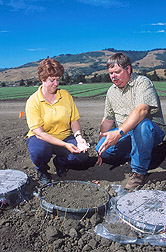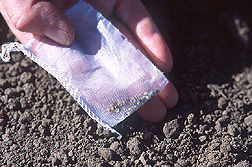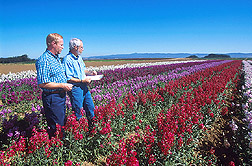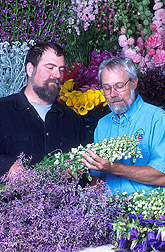Helping Flowers Fight
|
|
|
|
To form bright, beautiful blooms, plants such as gladioli and roses need to be protected against diseases, weeds, nematodes, and other natural enemies.
To provide that protection, growers often fumigate their fields before planting. The fumigant of choice? Methyl bromide, one of American agriculture's most widely used and most reliable farm chemicals. In fields where blooms will be produced for the cut-flower market, growers typically apply methyl bromide plus chloropicrin, a combination that zaps soilborne pathogens and weed seeds. |
|
|
Methyl bromide is being phased out, however, because of indications that it depletes Earth's ozone layer. The layer shields us—and other living things—from harmful doses of ultraviolet radiation.
To help growers of cut flowers cope with the impending loss of this widely used fumigant, ARS scientists in California and their university colleagues are working with flower growers to test an array of promising alternatives. The California Cut Flower Commission, based in Watsonville, is helping coordinate the research. Propargyl bromide is among the chemicals that might be used in place of methyl bromide. "Even though propargyl bromide is not new," says ARS agricultural engineer Thomas J. Trout, "little is known about it. And, it isn't registered by the U.S. Environmental Protection Agency for use as a pesticide." |
|
|
To find out more about this fumigant—fast—the U.S. Department of Agriculture recently allocated more than $1 million to finance ARS and university research on the compound. Trout, who leads the ARS Water Management Research Unit at Fresno, California, is coordinator of a cluster of USDA-funded propargyl bromide studies, including university investigations into its use as a preplant fumigant for floral crops.
Weed scientist Clyde L. Elmore and plant pathologist James D. MacDonald of the University of California at Davis lead the floral crops experiments. Results from tests they conducted in 2000 suggest that propargyl bromide or another contender, iodomethane, does as good a job—or nearly so—as methyl bromide plus chloropicrin in quelling some of a flower's worst soil-dwelling enemies. |
|
|
The Davis scientists used 20-gallon, black-plastic nursery pots as single, self-contained microplots. Sunk into the ground at test sites and filled with local soils ranging from light sandy loams to heavy clays, the microplots nearly replicate conditions in commercial growers' fields.
Elmore and MacDonald used more than four dozen of these microplots, in all, for their experiment. The study is among the first to scrutinize, in microplots, an assortment of fumigants as possible alternatives to methyl bromide plus chloropicrin for cut-flower production. Elmore and MacDonald installed the handy microplots at a test site near Davis, in northern California. They also set up other plots about 180 miles southwest of Davis, at coastal and inland sites near Watsonville. They used a syringe to inject candidate fumigants into the soil, mimicking—at a much smaller scale, of course—growers' preplant fumigation of fields. The researchers also buried, at various depths, small nylon bags containing spores of a notorious, soil-dwelling microbe calledFusarium oxysporum; seeds of weed pests such as field bindweed, little mallow, or common purslane; or species of destructive, microscopic worms called nematodes. Other sachets contained bits of reproductive material, called propagules, of calla lilies or gladioli. Perhaps surprisingly to home gardeners, the reproductive pieces are, according to Elmore, as much of a nuisance as weed seeds. "If you leave some propagules behind in the field after you harvest your crop, and don't kill them with a fumigant," he says, "they can sprout later and will contaminate your new crop. They may also carry over nematodes and pathogens to the next crop." Many home gardeners, in contrast, welcome the proliferation and spread—called naturalization—of their lilies and gladioli because it saves them the work of planting new bulbs or tubers. The researchers color-coded the little nylon bags for easy identification of the contents later on. They equipped each sachet with a long, nylon cord for easy removal of the bags at specially timed intervals during the experiment. The team applied methyl bromide plus chloropicrin in the standard 67:33 mix that growers of cut flowers use. In other microplots, they applied propargyl bromide at various depths and at rates ranging from 25 to 150 pounds per acre, iodomethane at 150 or 235 pounds per acre, or metam sodium at 320 pounds per acre. "Although results varied somewhat from site to site," reports Elmore, "we found that either propargyl bromide or iodomethane, applied at moderate rates, gave control that was nearly as good as methyl bromide. None of the chemicals knocked out field bindweed or little mallow, but that's been the case with methyl bromide plus chloropicrin, too." Elmore and MacDonald are repeating the tests this year. Their findings, though carried out in California—the nation's leader in cut-flower production—should also be useful in other states where cut flowers are grown. In 2000, America's cut-flower crop had a wholesale value of more than $427 million. Related work may help growers of garden roses, the kind home gardeners buy at the nursery as potted plants or as "bare-root" plants. Plant pathologists Sally M. Schneider and James S. Gerik, also of the ARS Water Management Research Unit, will start a new study this year at Jackson & Perkins' commercial garden-rose farm in Kern County, and at an ARS research site in Parlier, near Fresno. California growers in and around Kern County produce more than 50 percent of the nation's garden roses. Unlike the black-plastic microplots favored by the Davis team, Schneider will use 18-inch-diameter, 4-foot-long concrete pipes, turned on end and set into the ground, for her microplots. Her experiment targets harmful nematodes—in particular, root-knot nematodes. They feed on roots, robbing roses of vital carbohydrates. And the nematodes cause galls to form on roots. Galls interfere with the roots' ability to take up water and nutrients from the soil. Schneider plans to experiment with iodomethane plus chloropicrin and propargyl bromide applied through drip irrigation or injected directly into the soil and with drip-applied sodium azide, chloropicrin, InLine (Telone plus chloropicrin), and furfural compounds. "Our research," Schneider says, "will help nurseries supply pest-free plants for home gardens."—By Marcia Wood, Agricultural Research Service Information Staff.
This research is part of Methyl Bromide Alternatives, an ARS National Program (#308) described on the World Wide Web at http://www.nps.ars.usda.gov. Thomas J. Trout, Sally M. Schneider, and James S. Gerik are in the USDA-ARS Water Management Research Unit, 2021 S. Peach Ave., Fresno, CA 93727; phone (559) 453-3101, fax (559) 453-3088. |
|
"Helping Flowers Fight Soil-Dwelling Foes" was published in the September 2001 issue of Agricultural Research magazine. |
|










